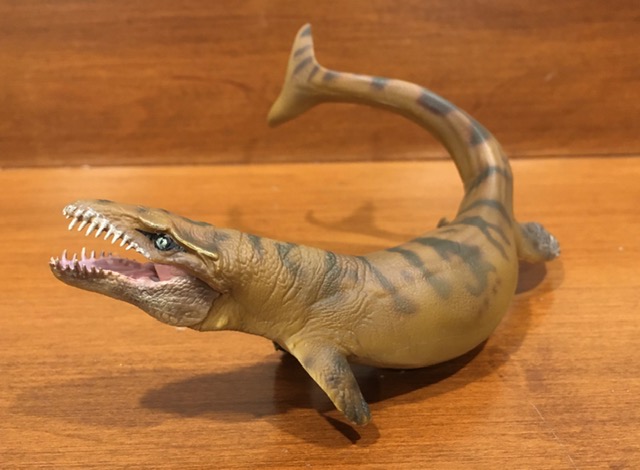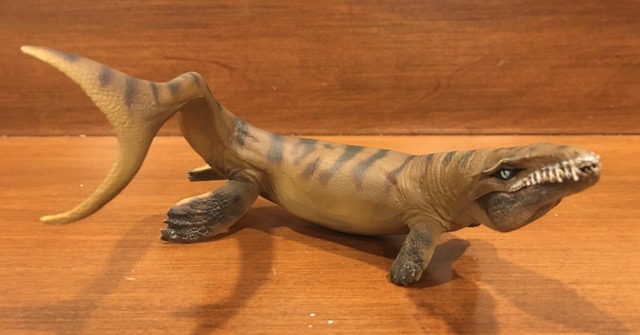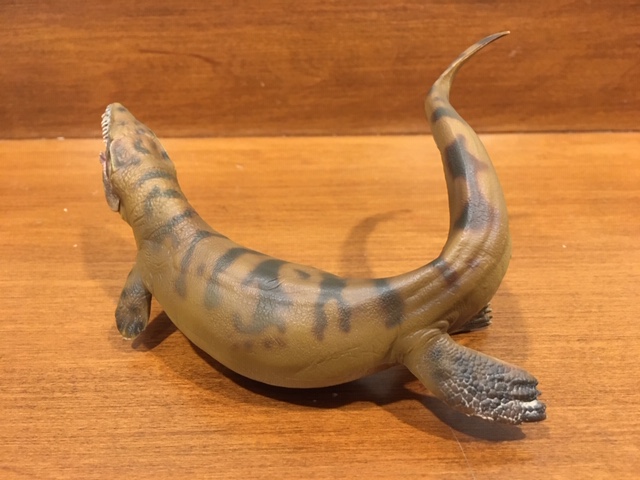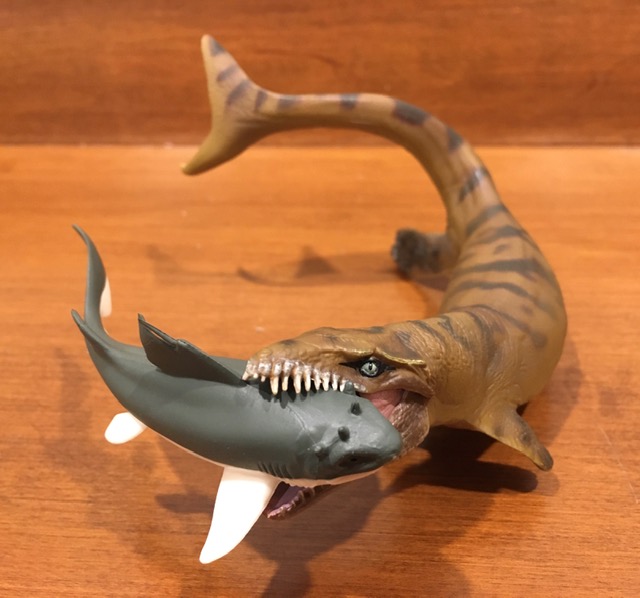Dakosaurus means “biter lizard,” a most appropriate name for any metriorhynchid. There are currently two recognized species: D. maximus from throughout Europe and D. andiniensis from Argentina. Unlike other metriorhynchids, D. andiniensis possessed a noticeably short, deep snout, which has led it to be nicknamed “Godzilla.” It is also the geologically youngest known metriorhynchid, hailing from the Early Cretaceous as well as the Late Jurassic.

As I noted a few years back in my review of the Wild Safari Plesiosuchus, metriorhynchids have rarely appeared in toy form. But PNSO has helped change that by releasing two Dakosaurus toys: a miniature-sized one and a much larger version for their mid-sized range. Both go by the moniker of Paulwin. Big Paulwin here is sculpted in a dramatic action pose with his head raised, his body turning to the right, and his long tail bent sharply to the right as well. It looks as though he is in the midst of circling a victim before closing in and making the kill. This gives him a length of about 14.5 cm from the tip of his snout to the end of his outstretched hind limbs.

Paulwin’s colours are somewhat similar to his distant modern relative, the saltwater crocodile: dull greenish brown with dark brown stripes on his dorsal side and sandy yellow on his ventral side. The tips of his flippers are blackened and his eyes are pale green surrounded by black markings, which give off a sinister appearance. His mouth is a dull pink and lined with off white teeth. The paint on my Paulwin’s teeth have been applied rather sloppily, unfortunately. Also, the flippers feature some of that odd pinkish wash that appeared on the large PNSO Spinops as well. I reckon they would’ve looked better without it.

Happily, no complaints can be made about Paulwin’s sculpting. His entire body is covered in a network of small scales, with larger ones visible on the head and the back of the neck. The neck and tail also feature thick wrinkles, which add to their muscular appearance. The largest scales are found on the flippers, which, due to their small claws, seem like a combination of sea turtle and seal. They also have the correct proportions, with the hind pair being considerably larger than the front pair. The inside of the mouth is nicely detailed, the teeth are long and pointy, and the profile of the skull makes Paulwin unmistakable as a specimen of Dakosaurus andiniensis. Incidentally, the miniature version has rows of osteoderms sculpted on its body. As fully aquatic reptiles, real metriorhynchids would not have possessed such features.

Those who enjoy playing with or simply posing their prehistoric figures will be pleased at how Paulwin’s lower jaw is articulated, enabling him to chomp down on various fish or even the flippers of neighbouring ichthyosaurs on the shelf. Moreover, his teeth interlock very neatly when his mouth is closed, just like the real deal. Dakosaurus grew to an estimated 4-5 metres long, which means it would have been a formidable predator capable of preying on anything from small fish to sharks like the Hybodus in the image below to ichthyosaurs as big or perhaps even bigger than itself. It probably took pains to keep away from giant pliosaurs, however!

Aside from some minor paint issues, I find Paulwin the Dakosaurus to be an excellent rendition of a very cool critter that has seldom appeared in toy form. I’ve been a fan of PNSO since their inception, but this new mid-sized series is by far my favourite out of the three. I eagerly look forward to what they have in store for 2020!

Disclaimer: links to Ebay and Amazon on the DinoToyBlog are affiliate links, so we make a small commission if you use them. Thanks for supporting us!




Nice review of this amazing figure.
It’s so full of delicate details .
The PNSO dakosaurus is a great figure, the only thing I don’t like about his figure is his careless paint, especially on the teeth. For the rest it is a figure with great detail and exquisitely sculpted, very realistic and dynamic. Thanks for the Suspsy article, I hope PNSO will make new prehistoric animal sculptures rarely marketed in the toy market.